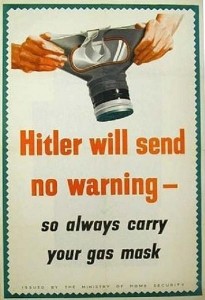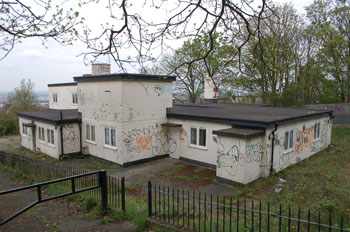
Building work has started behind the hoardings around Furze Lodge in Plum Lane; they are converting the one-time World War II Gas Decontamination Centre into a total of 12 flats. The previously existing six flats are being refurbished and extended, and a further six created by adding an additional storey. The graffiti-decorated building had been unoccupied for some time, and damaged by fire a couple of years ago, so it is good that it is being refurbished and cared for again. Neighbours of the development had objected on various grounds such as being overlooked, and the plans were changed so that proposed roof terraces were at the Plum Lane rather than the Dallin Road side of the building to prevent this.
For me an unexpected delight of the planning process is the production of a Heritage Statement when work is proposed on an historic building. These are fascinating documents if you are interested in local history, providing a professionally researched history of the building. I’m surprised such precious sources of information aren’t collected and stored together in case they disappear into the morass of planning documents. The Furze Lodge Heritage Statement had disappeared from the on-line planning system, presumably another victim of the redesign of the Royal Greenwich Council web site redesign, but a kind, if overworked, member of the planning department sent me a copy.

The Statement was written by Compass Archeology. They summarise the preparations for war in the Woolwich district, in particular on Shooters Hill which was a key strategic point on the second of three defensive “Stop Lines” around London – battle lines to stop or delay a Nazi offensive against the capital. The threat of aerial poison gas raids was planned for through the establishment of defensive procedures, which included the construction of Gas Cleansing and Decontamination Centres, such as the one on Plum Lane – built in just 8 weeks in December 1939 and January 1940. It was one of many in Woolwich district, others being set up in schools, public baths and health centres. The Heritage Statement describes the guidance on operation of the decontamination centre:
The Organisation of First Aid Posts and Gas Cleansing Stations was centrally controlled and a Ministry of Health Circular dated 30th December 1940 instructed that all such stations should be built following a central model plan (cf. Figs 9-11). The circular stated that: ‘The essential features are that the decontamination section consists of four units for each sex.
i) Outside stripping shed
ii) Inside undressing room
iii) Washing or shower room
iv) Dressing room.
The object is to prevent the spread of gas vapour from unit (i) onwards and each four compartments need to be sealed off from each other.
And they also suggest how this was implemented at Furze Lodge, in the diagram below (click to enlarge).

There’s a lot more about Shooters Hill during the Second World War in the Heritage Statement, in David Lloyd Bathe’s excellent history of Shooters Hill, “Steeped In History” which can be seen in the Heritage Centre, and also in the Digging Dad’s Army material linked to from the side panel and in previous posts. The Heritage Statement summarises what “Steeped in History” says about the war in Shooters Hill:
On the Hill there is evidence for structures for the defence of London such as pill-boxes (Bull Public House), anti-tank weapons and explosive booby traps. There is an air raid shelter in Oxleas Wood as well as numerous shelters in private gardens. The ARP had their Headquarters in Shrewsbury House, just across Plum Lane from Furze Lodge.
In 1940 Hitler decreed his ‘Directive 16’ or Operation Sealion as it became known. Britain’s Home Defence Executive, under General Ironside, laid out a plan for a series of defences called Stop Lines. These series of defensive lines were designed to stop or delay the enemy during the invasion. The defence lines were manned by the Home Guard. Around London there was an outer ring. (approximately on the line of what is now the M25), then a middle ring called ‘Stop Line Central’ which included Shooters Hill, and finally a central core around Whitehall. Gun placements were sited near Oxleas Wood and a Spigot Mortar on Eltham Common. On Eaglefield Park there were zig-zag trenches stretching from where the barrage balloon was sited to the pond, possibly as anti-glider trenching.
Bathe records a Fougase being set up on Shooters Hill ready to be ignited if enemy tanks advanced and there were Dragons teeth set up in Eglinton Hill and Brinklow Crescent (just west of the site). There were Barrage balloons in Eaglesfield Park, Shrewsbury Park (just south of the site) and Oxleas Meadow. A temporary water tank was located in the playground of Plum Lane School for the use of the fire service that was stationed there.
The local Home Guard was the 26th County of London Battalion and its HQ was Lowood House (south of the study site), under the charge of WWI veteran Lt. Col. Rothery-Moss, whom Bathe records as being of ‘the old school’. On Shooters Hill Golf Course was the 145 ‘Z’ AA Battery, with their HQ in a nearby house named ‘Invicta’. Their barracks were six nissen huts with a similar battery on Blackheath. The Shooters Hill site was later used as a POW camp.
During the course of the war Woolwich suffered 1604 high explosive bombs, 82 V1s, 32 V2s and thousands of incendiaries. There had been 717 deaths and 5,207 injuries. Of the 38,000 housing stock 1670 had been destroyed, 1610 seriously damaged and 34,199 slightly damaged. On the upper reaches of the Hill there was very little damage, the WWII Bomb damage maps in Greenwich Heritage Centre show some general blast damage to the north, either side of Dallin Road, but nothing else in the immediate vicinity.
The Gas Decontamination Centres was never used in practice, there were no poison gas raids, so future residents don’t need to worry about lingering contamination. And from its situation on the summit ridge of Shooters Hill they will have amazing views over London and down to the river.

PS I’ve asked for the broken links on the planning application page for Furze Lodge to be fixed, following which the Heritage Statement should be here.